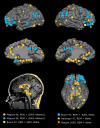Dreaming and the brain: from phenomenology to neurophysiology
- PMID: 20079677
- PMCID: PMC2814941
- DOI: 10.1016/j.tics.2009.12.001
Dreaming and the brain: from phenomenology to neurophysiology
Abstract
Dreams are a remarkable experiment in psychology and neuroscience, conducted every night in every sleeping person. They show that the human brain, disconnected from the environment, can generate an entire world of conscious experiences by itself. Content analysis and developmental studies have promoted understanding of dream phenomenology. In parallel, brain lesion studies, functional imaging and neurophysiology have advanced current knowledge of the neural basis of dreaming. It is now possible to start integrating these two strands of research to address fundamental questions that dreams pose for cognitive neuroscience: how conscious experiences in sleep relate to underlying brain activity; why the dreamer is largely disconnected from the environment; and whether dreaming is more closely related to mental imagery or to perception.
Published by Elsevier Ltd.
Figures


References
-
- Arkin AM, et al. The mind in sleep: Psychology and psychophysiology. Lawrence Erlbaum Associates; 1978.
-
- Ellman SJ, Antrobus JS. The mind in sleep: Psychology and psychophysiology. Willey; 1991.
-
- Hobson JA. The Dreaming Brain. Basic Books; 1988.
-
- Hobson JA. REM sleep and dreaming: towards a theory of protoconsciousness. Nat Rev Neurosci. 2009;10:803–813. - PubMed
-
- Freud S. The modern library. 1900. The Interpretation of Dreams.
Publication types
MeSH terms
Grants and funding
LinkOut - more resources
Full Text Sources

